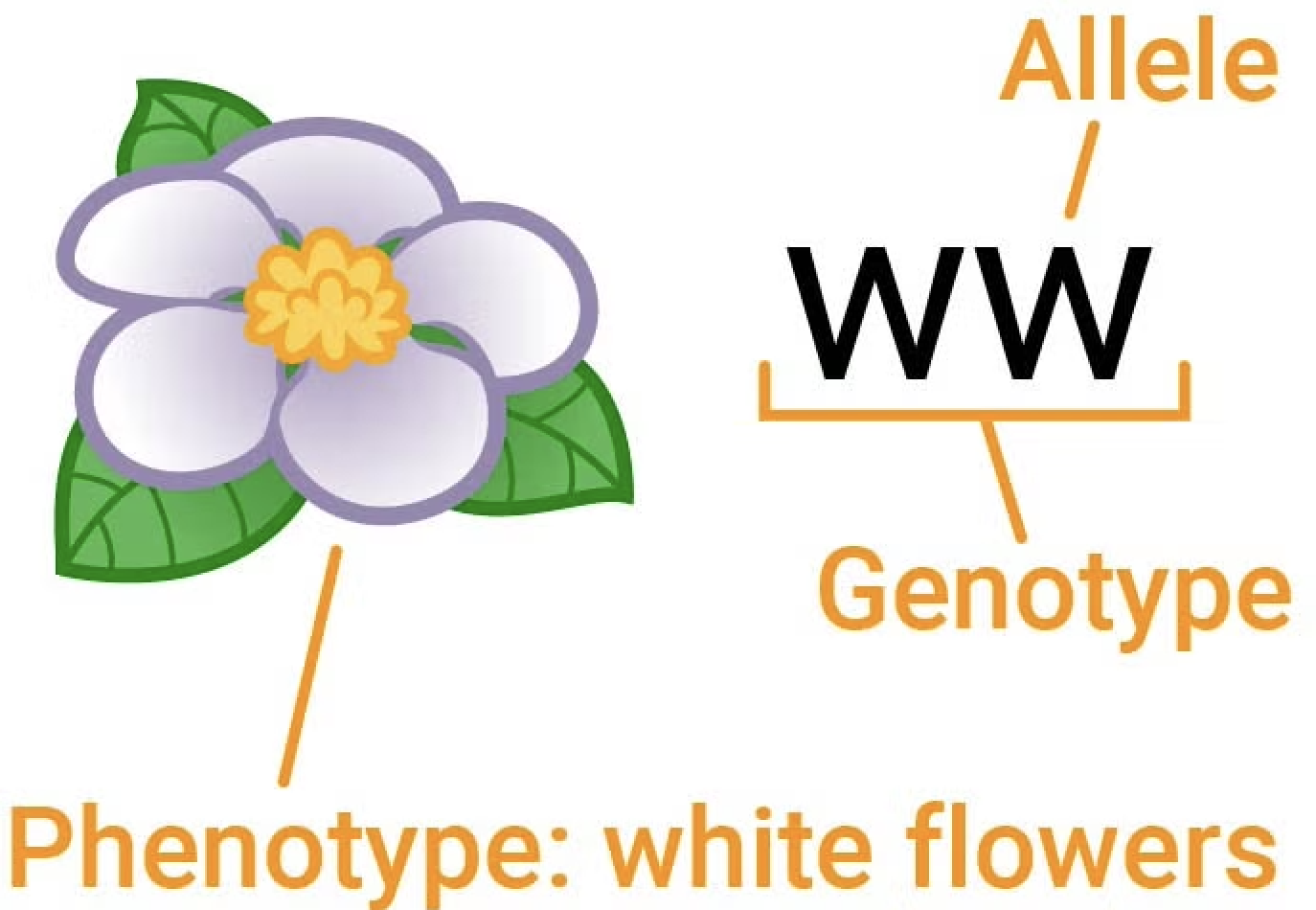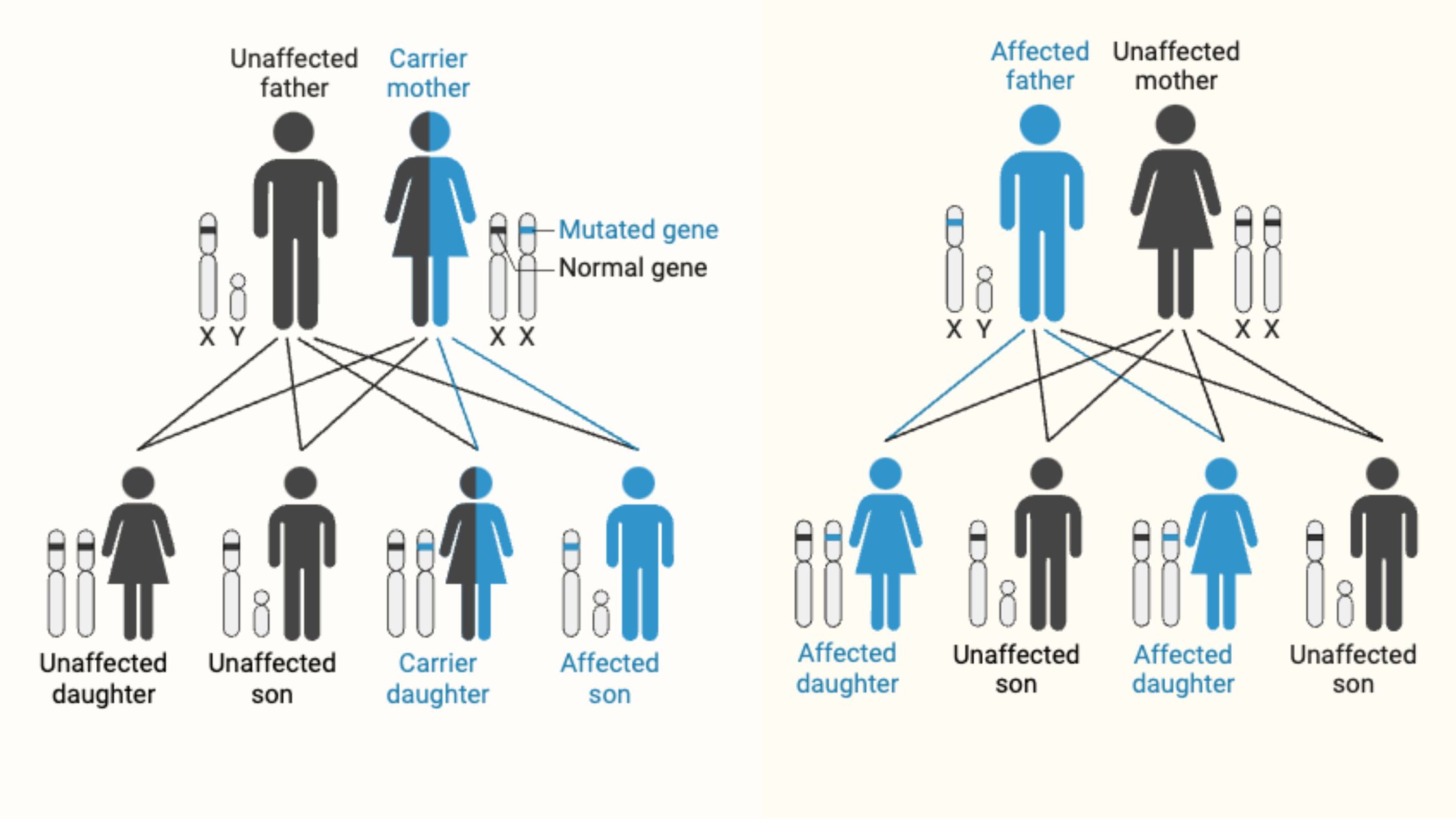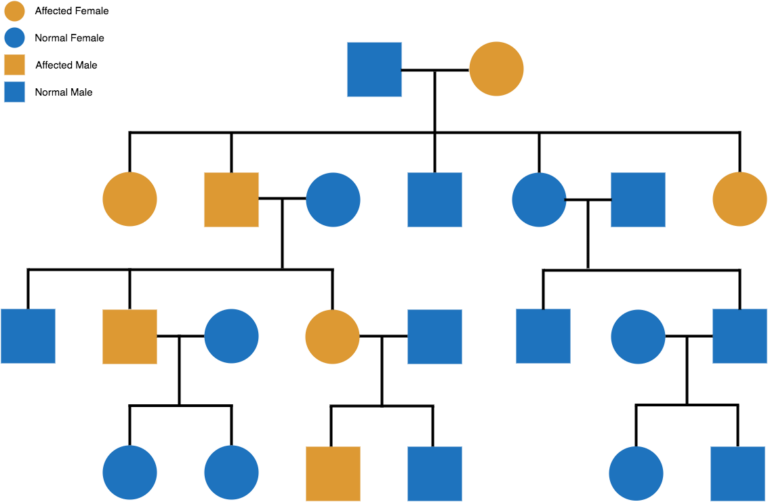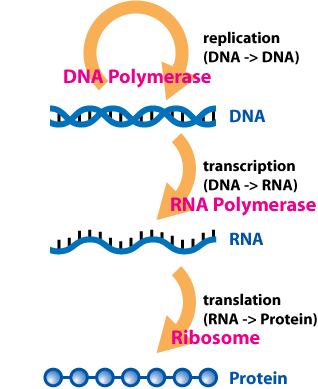Genetics Year 10
1/40
There's no tags or description
Looks like no tags are added yet.
Name | Mastery | Learn | Test | Matching | Spaced |
|---|
No study sessions yet.
41 Terms
Phenotype
The trait shown: What you see\ observable characteristics or traits It’s the result of genotype + environment. e.g. Eye colour, Hair type, Height, Blood type. Usually visual.

Genotype
Genotype is the genetic makeup of an organism (BB). E.g. looking at eye colour Brown eyes: B blue eyes: b the Genotypes could be BB bB bb the trait shown would be brown eyes (that a phenotypes)
Allele
a different version of the same gene. eg: if the trait is eye colour the alleles could be blue eyes: b brown eyes: B green eyes: g etc.

Gamete
A gamete is a sex cell — the special kind of cell used in sexual reproduction.
Male gamete = sperm, Female gamete = egg. they only carry one allele so they need to combine to make the combo.
Somatic cells
Somatic cells are all the body cells except the gametes (sperm and egg) eg. the skin cells, eye cells, brain cells. Somatic cells = all body cells except sex cells. They have a full set of chromosomes (2 alleles per gene) They don’t get passed on to offspring
Autosomal
Autosomal refers to any chromosome that is not a sex chromosome. eg. Chromosome 1, Chromosome 7
Haploid
A haploid cell has 23 chromosomes (not pairs).It's found in sperm and egg cells. It's made by a special process called meiosis. When a sperm and egg join, they make a baby cell with 46 chromosomes. This helps babies have the right number of chromosomes. It also helps make everyone genetically different.
Diploid
Contains two sets of chromosomes (pairs) — one from each parent. In humans, that means 46 chromosomes total (23 pairs). Found in somatic (body) cells like skin, muscle, and blood cells. Formed by mitosis, the normal cell division for growth and repair. Maintains the species-specific chromosome number across generations. Each pair consists of homologous chromosomes (similar but not identical).
haploid vs diploid
Haploid (n):
Has 23 chromosomes
No pairs, just one set
Found in sperm and egg cells
Made by meiosis
Diploid (2n):
Has 46 chromosomes
Pairs of chromosomes (23 pairs)
Found in regular body cells
Made by mitosis
Created when sperm and egg join
Breakdown of that: Haploid cells combine to restore the diploid number in offspring. This cycle keeps chromosome numbers stable over generations. Haploid cells allow for mixing of genes, increasing variation.
Complimentary bases for DNA and RNA
DNA: T-A, G-C
RNA: U-A, G-C (replace the T with U)

DNA vs RNA
DNA vs RNA (thymine ➡ uracil) DNA is like the master blueprint — it’s double-stranded and has thymine (T) as one of its bases. RNA is like a working copy — it’s single-stranded and instead of thymine, it uses uracil (U). Both have adenine (A), cytosine (C), and guanine (G) DNA stays in the nucleus, RNA moves out to help make proteins. Basically, RNA replaces thymine (T) with uracil (U) but does the same job reading the code.
Gene
A gene is a segment of DNA that contains the instructions to make a specific protein or control a particular trait. Each gene tells your cells how to make something important, like eye colour or blood type. Genes are made up of sequences of nucleotides (A, T, C, G). Different versions of a gene are called alleles. Genes are the BB, bB and the A, T, C, G.
Dominant allele vs Recessive allele
a dominant allele overpowers the recessive allele and can be expressed in these combos BB, Bb whereas a recessive allele can only be expressed when its bb because it is overpowered by the Dominant allele.
Punnet squares and ratios
if its 2 and 2 ratio is 1:1

X and Y
XX-female, XY-male are the sex chromosomes related to the male and females
Sex-linked inheritance
Sex-linked inheritance means a gene is on the sex chromosomes (usually the X). Boys (XY) only have one X, so if they get a faulty gene there, they show the trait. Girls (XX) have two Xs, so they usually need two faulty genes to show it. That’s why some traits, like color blindness, happen more in boys.

Heterozygous and heterozygous
Heterozygous: Heterozygous means having two different alleles for a gene eg. Bb is heterozygous. And the phenotype would be B
Homozygous: Homozygous means having two identical alleles for a gene eg. BB or bb is Homozygous. And the phenotype would be B or b
Mitosis
Mitosis is the process where a cell divides to make two identical cells. It happens in several phases. (me too sis, splits into 2 identical ones)
Mitosis is important because it helps your body grow, heal cuts, and replace old or damaged cells. It makes sure that each new cell has the exact same DNA as the original one
Prophase
The chromosomes condense and become visible. The nuclear membrane starts to break down.
Metaphase
Chromosomes line up in the middle of the cell.
Pedigree
Pedigree: males are squares females are circles: the coloured in one is the trait shown

Anaphase
The chromosome pairs separate and move to opposite ends of the cell.
Telophase
New nuclear membranes form around each set of chromosomes.
Cytokinesis
The cell splits into two identical cells.
Meiosis
Mitosis: Meiosis is how your body makes sperm and egg cells. It splits the cells twice to make four cells with half the normal number of chromosomes. This helps babies have the right number of chromosomes and makes each baby unique.
Mitosis
Mitosis is important because it helps your body grow, heal cuts, and replace old or damaged cells. It makes sure that each new cell has the exact same DNA as the original one
Mitosis vs Meiosis: Mitosis
makes body cells. It creates two identical cells with the full set of chromosomes. It helps you grow and heal. Meiosis makes sex cells (sperm and eggs). It makes four cells with half the chromosomes. This helps with reproduction and genetic variety.
Chromosomes
Chromosomes are tiny packages inside cells that hold your genes and contain DNA. They carry the instructions that tell your body how to grow and work. People usually have 46 chromosomes in each body cell.
Autosomal/somatic
Humans have 23 pairs of chromosomes in total. 22 pairs are called autosomal chromosomes or somatic chromosomes. These carry most of the genes that control your body’s traits (like hair colour or height).
1 pair is the sex chromosomes (XY or XX), which decide if you’re biologically male or female.
So, autosomal/somatic chromosomes are the 22 pairs that aren’t related to sex, and the sex chromosomes are the 1 pair that determines biological sex. So 46 in total
Karyotyping
Karyotyping is a test that looks at all the chromosomes in a cell. It arranges the chromosomes in pairs from largest to smallest, ending with the sex chromosomes (XX or XY).
Its function is to check for problems like missing, extra, or damaged chromosomes. Doctors use karyotyping to find genetic disorders, like Down syndrome (which has an extra chromosome 21).
Haploid into diploid
During fertilization, one sperm cell and one egg cell come together. Each is haploid, meaning they have 23 chromosomes. When they join, they form a diploid zygote with 46 chromosomes. This diploid cell has a full set of chromosomes — half from the mother and half from the father — and it will grow into a baby.
Polymers
Polymers are long chains made up of repeating smaller units called monomers. You can think of a polymer like a necklace, and each bead is a monomer. When lots of monomers join together, they form a polymer.
Examples: DNA is a polymer made of monomers called nucleotides. Proteins are polymers made of amino acids. Plastics (like in water bottles) are synthetic polymers made in factories.
DNA
DNA stands for Deoxyribonucleic Acid. It’s the genetic code that tells your body how to grow, work, and look. DNA is like an instruction book inside your cells. It’s shaped like a twisted ladder (called a double helix), and it’s made of smaller parts called nucleotides. The rungs of the ladder are pairs of bases: A with T, C with G Your DNA is stored in your chromosomes, and it carries all your genes — the instructions for your traits.
RNA
RNA stands for Ribonucleic Acid.
It’s like a copy of DNA that helps the cell make proteins. While DNA stays safe in the nucleus, RNA goes out to the rest of the cell to tell it what to build.
How its different
Here’s how it’s different from DNA: RNA is single-stranded (DNA is double). RNA uses uracil (U) instead of thymine (T). RNA is shorter and used as a messenger or helper in making proteins. So, DNA is the full instruction book, and RNA is like a quick note copied from it to do one job.
RNA process: Transcription – A copy of DNA is made as mRNA (messenger RNA). RNA uses U instead of T.
Translation – The mRNA (messenger RNA) goes to a ribosome, which reads it and builds a protein using amino acids.
DNA → mRNA → Protein

Nucleotides (structure)
a Nucleotides is the base, the A,T,C and G (and U for RNA) A nucleotide is the building block of DNA and RNA. It has three parts: A sugar (deoxyribose in DNA, ribose in RNA) A phosphate group. A nitrogenous base (A, T, C, or G in DNA; A, U, C, or G in RNA) These parts join together to form the long chains of DNA or RNA.
Hydrogen bonds between bases
Hydrogen bonds are weak attractions that hold the two strands of DNA together by connecting the bases. They form between specific base pairs: Adenine (A) pairs with Thymine (T) using 2 hydrogen bonds. Cytosine (C) pairs with Guanine (G) using 3 hydrogen bonds. These bonds keep the DNA’s double helix stable but still easy to separate when the cell needs to read or copy the DNA.
Proteins
Proteins are tiny machines in your body that do lots of important jobs. They help build parts of your body, fix things, and help keep you healthy. Proteins are made from building blocks called amino acids. Your DNA tells your body how to put these amino acids together.
Amino acids
Amino acids are the small building blocks that join together to make proteins.
There are 20 different kinds of amino acids, and the order they connect in decides what type of protein is made.
Production
Amino acids are made by your body or come from food.
Proteins are made when amino acids join together in the order your DNA tells the cell. This is called protein synthesis.
Transcription vs Translation
Transcription is when DNA is copied into messenger RNA (mRNA) inside the nucleus.
Translation is when the mRNA is read by a ribosome to build a protein from amino acids.
So, transcription = DNA → mRNA, and translation = mRNA → protein.